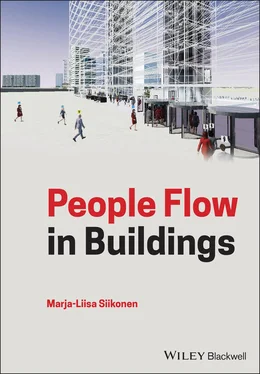8 Chapter 17Table 17.1 Side‐opening (SO) and centre‐opening (CO) door widths with typica...Table 17.2 Examples of time consumed in stopping in offices and hotels (ISO ...Table 17.3 Typical nominal travel time criteria for speed selection.Table 17.4 Variations of elevator flight‐time equations.Table 17.5 Flight times according to Eqs. (17.19) and (17.22) and probable j...Table 17.6 The components of the roundtrip time equation considering r ‐floor ...Table 17.7 Flight times for typical floors , t r , and over express zone , t s , exTable 17.8 Up‐peak RTT from the main entrance to 14 upper floors calculated ...Table 17.9 Additional RTT caused by the three entrance floors calculated fro...Table 17.10 Round trip times for paternoster and conventional duplex and qua...
9 Chapter 18Table 18.1 Calculated P 0‐ and q w‐values for different group sizes.Table 18.2 Calculated and simulated ATT‐values for a 16‐floor building.Table 18.3 Calculated and simulated ATT‐values for a 23‐floor building.
10 Chapter 19Table 19.1 LOS definition by Fruin (1987).Table 19.2 LOS definitions for pedestrian speed on walkways.Table 19.3 Pedestrian characteristics suggested for an elevator in a resort...Table 19.4 Rated passenger capacities and loads, and car internal areas of ...Table 19.5 LOS for different car load factors.Table 19.6 Theoretical maximum (EN 115‐1 2008) for escalator handling capac...Table 19.7 k ‐Values for maximum number of passengers on escalators.Table 19.8 Maximum escalator handling capacities in persons per hour.Table 19.9 Nominal observed (ASME A17.1 2013) escalator handling capacities...Table 19.10 Transportation capacities of 1000 mm (40 in)‐wide or wider movi...Table 19.11 Observed people movement characteristics in a 1400 mm‐wide and ...Table 19.12 Maximum door speed of automatic revolving doors (International ...Table 19.13 Side-opening (SO) and centre-opening (CO) elevator door widths ...Table 19.14 Pedestrian handling capacity in various types of turnstiles ....Table 19.15 Handling capacities of DOP s.
11 Chapter 21Table 21.1 Four traffic mix areas in an OD matrix.
12 Chapter 23Table 23.1 The simulated RTT frequencies, f i.
13 Chapter 24Table 24.1 Buildings and zoned elevator groups with handling capacity of 12...Table 24.2 Up‐peak handling capacities for different number of cars in the ...Table 24.3 Simulated car load factor and waiting times according to demand.Table 24.4 Relative handling capacities for three traffic mixes for differe...Table 24.5 Simulated and calculated waiting time distributions.
14 Chapter 26Table 26.1 Rated load selection based on mass from the maximum number of pe...Table 26.2 The maximum number of persons allowed in the car and average num...
15 Chapter 27Table 27.1 Design criteria for elevator selection (ISO 8100-32:2020).Table 27.2 Passenger waiting time recommendation where walking time is not ...Table 27.3 Passenger time to destination recommendation where walking time ...
16 Chapter 29Table 29.1 Use of stairs.Table 29.2 Use of escalators and elevators.
17 Chapter 30Table 30.1 Elevator core areas including elevator lobbies at the main entra...Table 30.2 Elevator core areas including elevator lobbies at the main entra...Table 30.3 Elevator main lobby areas of three sky lobby arrangements with t...Table 30.4 Elevator main lobby areas of three sky lobby arrangements with t...Table 30.5 Elevator core space demand with different elevator arrangements.
18 AppendixTable A.1 Passenger transfers through security gates in Poland.Table A.2 X 2‐test data for entering passengers through the security gates on 7 J...Table A.3 X 2‐test data for exiting passengers through the security gates on 7 Ja...Table A.4 Typical daily traffic profile of a multi‐tenant office building.Table A.5 Typical daily traffic profile of a single‐tenant office building.Table A.6 Typical daily traffic components of a hotel in Egypt.Table A.7 Typical daily traffic profile of a residential building.Table A.8 Typical profile for hospital visitors.
1 Chapter 1 Figure 1.1 An example of a layout drawing with NIA of KONE Building. Figure 1.2 Office multi‐occupant floor descriptions for upper floors. Figure 1.3 Gross internal area of a residential apartment.
2 Chapter 2 Figure 2.1 Four vectors of passenger traffic per floor. Figure 2.2 Camera installed above the doorway for people‐flow counting (a) a... Figure 2.3 Curtain‐of‐light (a), and infra‐red proximity sensor (b) in a doo... Figure 2.4 Access control system built in turnstiles (KONE Corporation). Figure 2.5 Load‐weighing by platform deflection (a), and strain gauge... Figure 2.6 Step‐counting method to count the number of entering and exiting ... Figure 2.7 Traffic view of E‐Link monitoring system (KONE Corporation). Figure 2.8 Elevator performance analyzer setup in an elevator. Figure 2.9 Modern user real‐time tracking service. Figure 2.10 Wayfinding by a mobile phone.
3 Chapter 3 Figure 3.1 Passenger inter‐arrival times in elevator lobbies. Figure 3.2 Probability density function for Poisson arrival process. Figure 3.3 Number of occurrences as a function of number passengers analysed... Figure 3.4 Passengers entering (a) and exiting (b) through turnstiles for a ... Figure 3.5 Combined inter‐arrival times of entering and exiting people throu... Figure 3.6 A snapshot of a video recording from the first entrance floor (... Figure 3.7 Cumulative number of batch and individual arrivals at the entranc... Figure 3.8 Setup of people flow counting in escalators. Figure 3.9 Observed daily passenger batch size distributions of the globally...
4 Chapter 4 Figure 4.1 Incoming, outgoing and inter‐floor traffic components of a buildi... Figure 4.2 Lobby layout of an office building in Poland. Figure 4.3 Typical people flow in diversified office buildings (a), p... Figure 4.4 Measured traffic in an office building for the two‐way traffic pr... Figure 4.5 Occupancy in persons during the day for the office building in Po...Figure 4.6 Example of transportation arrangement in an office building.Figure 4.7 Observed people flow in office building lobbies in Finland (a), S...Figure 4.8 Automatically recorded data by group control system of a multiten...Figure 4.9 Example of transportation devices in a hotel building.Figure 4.10 Traffic‐flow chart of a motel and a hotel (a), and observ...Figure 4.11 Example of elevators of a residential building.Figure 4.12 Two‐way traffic flow for Strakosch apartment building (a).Figure 4.13 An example of transportation device arrangement in a medical bui...Figure 4.14 Hospital traffic by Strakosch (1983) (a), observed two‐wa...Figure 4.15 Examples of transportation devices in commercial and public buil...Figure 4.16 Example of modelled distribution of numbers of escalators servin...Figure 4.17 Probabilities of passenger arrivals in escalators in a shopping ...Figure 4.18 Lobby traffic‐flow chart in a department store (a), and d...Figure 4.19 Duration of the visits and number of visitors during the weekday...Figure 4.20 Popular times in Empire State Building on Fridays.Figure 4.21 Example of elevator arrangement in a cruise ship.Figure 4.22 Traffic profiles of guest traffic in a cruiser during boarding i...
5 Chapter 5Figure 5.1 Passenger service quality parameters for elevators.Figure 5.2 People flow per floor from an office building in Finland.Figure 5.3 Landing (hall) call time distribution before and after modernizat...Figure 5.4 Passenger waiting time (a), and journey time (b) distribution wi...Figure 5.5 Monthly service times of passenger elevators with destination con...Figure 5.6 Monthly service times of quest elevators with conventional contro...Figure 5.7 Number of starts of passenger elevators with destination control ...Figure 5.8 Number of starts of quest elevators with conventional control in ...Figure 5.9 Number of elevator starts during a day in an office building in E...Figure 5.10 Number of elevator round trips per day.
Читать дальше












